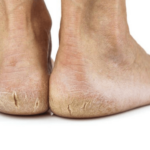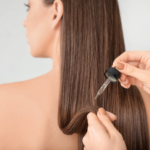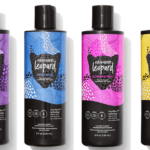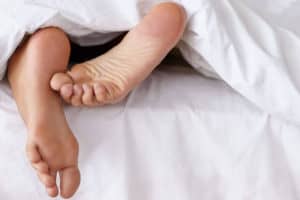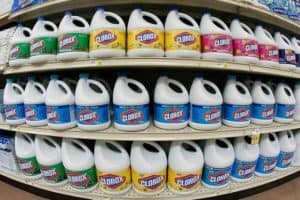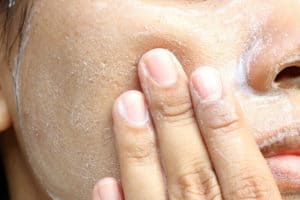Hair comes in a variety of textures and colors, but what exactly is it made of? Learning what your hair is made of would help you in maintaining its health, thickness, and natural color.
Is hair made of protein, dead skin cells, or something else? All the hair on your body is made of a protein substance called keratin. Although hair and dead skin cells utilize the same materials in their formation, the hair has an internal matrix that’s the same as the cells of the epidermis.
The cells found at the root of the hair follicles are living cells, while those that have been keratinized and found at the end of the hair shaft are dead cells.
Read on to learn more about what hair is made up of, how hair grows, and how to maintain healthy hair.
Is Hair Made of Protein, Dead Skin Cells, or Something Else?
Hair and nails are considered special appendages as they can be composed of both living and dead cells.
Hair is made from a hair follicle located on the dermis of the skin. This hair follicle is connected to a sebaceous gland that is responsible for supplying oil to the hair. The root attaches the hair to the skin.
Each hair follicle has a hair bulb where the hair’s living cells grow and divide. As the hair grows longer and surfaces from the epidermis, nourishment towards the hair’s end is stopped. Thus, the cells die and become “dead cells.” That’s why you can cut off your hair without feeling any pain.
However, when you pull off your hair from its roots, you can feel a certain pain. The reason is that the hair, which is still attached to the follicles in the dermis, is composed of living cells.
There are tiny blood vessels feeding the hair at the follicle or bulb to grow longer. Some of these substances are hormones and essential proteins (keratin) needed for hair growth. Melanin is also present as it gives color to your hair based on your inherited genes.
Parts of the Hair
Your hair is made up of two parts: the root (living part) and the shaft (dead part).
The root or bulb of the hair is surrounded by a follicle. The follicle is typically attached to a sebaceous gland. As previously mentioned, the hair follicle is found in the dermis, which is the middle layer of the skin. It’s between the epidermis (outermost layer of the skin) and the subcutaneous layer (innermost tissue of the skin).
The hair itself is composed of three layers:
- Cuticle (outermost layer)
- Cortex (middle layer)
- Medulla (innermost layer)
Composition of Hair
The primary components of your hair are keratin and melanin. Aside from these components, your crowning glory is also made of the following substances:
- Sulfur = 5%
- Nitrogen = 15%
- Carbon = 45%
- Oxygen = 28%
- Hydrogen 7%
Is Hair Made of Dead Skin Cells?
People may say that the hair is made out of dead skin cells because it has a component similar to dead skin. Dead skin is composed of keratinized cells that contain keratin, which is a common fibrous protein found in nails, hair, and skin.
The hair at the surface of the skin is also made up of keratinized dead cells, making them the same as dead skin cells. However, the cells found in hair follicles are living cells.
How Does Hair Grow?
Normally, hair grows half an inch every month. The 1st phase of hair growth is the anagen, which runs the longest and could go on for years. In this phase, hair grows quickly as cells undergo the process of mitosis. This process is enhanced by the support of the blood vessels of the follicle’s hair papilla.
The 2nd phase is the catagen (2 to 3 weeks), where the growth of hair is decreased because the blood flow has stopped.
The 3rd phase is the telogen (3 months), where the hair follicle is at rest, and the growth of hair stops altogether. Usually, when old hair falls out, a new one grows, too. You can lose about 100 hair strands daily. However, there’s no need to worry as new hairs are formed to prevent baldness.
Hair Problems and Their Treatments

1. Excessive Hair Growth
In this case, laser hair removal could be used. The laser is directed at the hair cells to prevent them from growing new hair. Another option is hair electrolysis. In this method, the roots of the hair are destroyed using an electrical current.
2. Hair Loss or Baldness
Treatment with minoxidil or Rogaine will do. This medication has been successful in many individuals. If you’re allergic to the contents of minoxidil, you can use Propecia as an alternative. Propecia is also effective when it comes to hair regrowth and the prevention of hair loss.
If these two medications do not work, you can opt for a hair transplant, which is a surgical procedure. In this procedure, hair follicles are transplanted with new hairs to eliminate areas of the scalp with no hair growth.
3. Too Oily or Too Dry Hair
When your hair is too oily, you will have to shampoo it more often to reduce oil production. When it’s too dry, you can have it oil-treated or just shampoo less often. Hair preparations such as olive oil could also help revive your dry hair.
Hair experts recommend that hair could be shampooed a maximum of three times a week to retain its natural oil. Alternatively, shampooing less often can cause the accumulation of dirt and dead cells, which can clog hair follicles and lead to an infection.
4. Alopecia Areata
This condition is characterized by bald patches on the head. This disorder can be treated by a hair transplant or medications such as minoxidil or Rogaine. Sometimes, hair can regrow on these bald patches without treatment.
5. Seborrheic Dermatitis or Dandruff
Dandruff can be treated with an anti-dandruff shampoo that is suitable for your scalp type. There are many anti-dandruff shampoos in the market that you can use without a prescription from your doctor. You may want to experiment with which brand works for you the best.
6. Trichomycosis Nodularis or Piedra
This fungus causes hair loss due to the infection of the hair shaft. The condition is treated with antifungal creams and other topical preparations that are prescribed by your doctor. In severe cases, oral antifungal medications may be required.
7. Head Lice
You can use a shampoo specifically formulated to kill head lice. Shampooing regularly could help eliminate and prevent the growth of head lice as well.
8. Folliculitis (Inflammation of the Hair Follicles)
Folliculitis is caused by Staphylococcus aureus, a gram–positive bacterium that can infect wounds and other body openings. A mild infection can be cured by antibiotic gels or creams. In serious cases, oral antibiotic treatment may be necessary. Nevertheless, antibiotics such as clindamycin or cephalexin may be prescribed by your healthcare provider.
Essential Nutrition for Proper Hair Growth
You need some nutrients for the proper growth of your hair. You can get these nutrients from natural foods and supplements, which include:
- Omega-3 Fatty Acids – You need these healthy fats to maintain your hair’s natural oil. Omega-3 fatty acids also promote skin and scalp health. Sources of these fatty acids are fish (mackerel or sea bass), walnuts, soya beans, and flax seeds.
- Vitamins – The most important ones are vitamins A, B, C, and D. Vitamins A and C help promote healthy skin and hair. When your scalp is healthy, your hair growth also tends to be healthy. Vitamin B and D also promote healthy skin, providing a healthy scalp for your hair growth. You can naturally get your vitamins from fruits and vegetables or you can buy commercially prepared supplements.
- Water – Your hair cells and scalp require water to stay healthy and function well. Without water, essential nutrients cannot be exported to the hair cells. Hydrate yourself adequately by drinking lots of water. Avoid consuming soda or carbonated drinks as they are unhealthy substitutes for water. Additionally, you can moisturize your scalp or hair by applying hair and scalp moisturizers.
- Biotin – This substance can come from lentils. It’s responsible for enhancing your hair growth. You can also get biotin from carrots, walnuts, and cauliflower.
- Zinc – This nutrient is important for the prevention of hair loss and the promotion of healthy hair follicles. You can get zinc from seafood, such as clams, oysters, lobsters, and others. You could also obtain zinc from sunflower seeds, lamb, cereals, peanuts, and pork.
- Iron – Your hair follicles require healthy red blood cells (RBC) to function well, and RBCs must have enough iron to properly perform their biochemical reactions. Iron can come from green, leafy vegetables, liver, lean meat, oysters, and other greens.
- Protein – The hair’s essential protein is keratin. Without keratin, your hair won’t be able to grow quickly and healthily. You can get protein from fish, lean meat, eggs, or legumes.
Hair Care Tips

1. Cut Your Hair Regularly
Cutting your hair regularly will maintain proper grooming and healthy hair. Split ends are eliminated, and hair is easier to style and manage.
2. Shampoo Once Every 2 or 3 days
Shampooing once every 2 or 3 days is recommended by experts to maintain the amount of oil needed for healthy hair. Shampooing often will increase the loss of natural hair oil, leading to dry hair.
3. Reduce Your Stress Levels
According to some studies, stress can cause hair loss as the hair follicles go into a resting mode, unable to produce new hair. Hence, don’t stress yourself too much. When you’re losing hair, and you can’t pinpoint the exact cause, it’s time to think about your stressors. Perhaps, you’re so stressed that your health is already affected.
4. Avoid Combing Wet Hair
Don’t comb wet hair as you can damage it and pull some strands out. Dry your hair gently before combing. You can use a fine-toothed comb for straight hair and a wide-toothed comb for curly hair.
5. Use Suitable Hair Ornaments
Use appropriate hair ornaments when styling your hair. Don’t use hair clips that can unnaturally twist your hair. Hair buns must sit well on your head and should be comfortable. Don’t sacrifice comfort for fashion and trends.
6. Use Hair Conditioners and Shampoos Properly
Don’t overuse these hair products. Only use a small amount of product according to the length of your hair. Afterward, you have to rinse off the shampoo and conditioner thoroughly. Use warm water as much as possible to rinse your hair.
7. Avoid Hot Curls and Other Heat-styling Devices
These devices can damage your hair, especially if they are repeatedly used. You can use them on special occasions instead.
8. Eat Nutritious Foods Rich in Calcium, Vitamin C, & D
Your hair needs calcium, vitamin C, and D to stay healthy. Calcium can prevent alopecia and can strengthen hair strands. In a 2012 study about hair growth by Translational Medicine, vitamin D can help create new hair follicles. The creation of new hair follicles promotes the growth of hair.
Conclusion – Is Hair Made of Protein, Dead Skin Cells, or Something Else?
As discussed earlier, hair is made up of two types of cells: the living cells and the dead cells. The living cells are found in the root of the hair follicles that are attached to the dermis of the skin, while the dead cells are found at the shaft’s end, where hair nourishment is stopped.
Additionally, hair contains a protein called keratin and a color substance called melanin. These substances are responsible for hair growth and hair color.
Follow the tips given in this article and learn how to manage your hair properly to have a healthy and luxuriant crowning glory.

![How to Get Dead Skin Off Lips [6 Natural Remedies] how to get dead skin off lips](https://skincaregeeks.com/wp-content/uploads/2021/04/how-to-get-dead-skin-off-lips-150x150.jpg)
